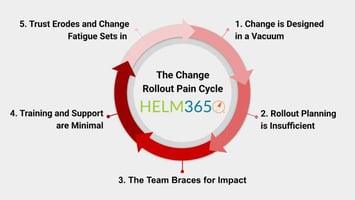So many change efforts stall. It doesn’t have to be this way. Most teams don’t resist change...
5 Steps to Becoming a Change-Resilient Team

Change isn’t just an occasional disruption anymore—it’s relentless and ever-present. Digital shifts, company restructures, shifting customer needs, and broad global uncertainty all add up, creating a constant current of change that teams are expected to navigate. Even the highest performers are feeling stretched to the limit.
So let’s start from a shared understanding: change is not just inevitable, it’s immediate. That means leaders have a responsibility to shepherd their teams through this rapidly evolving landscape. Instead of cycling through confusion, resistance, exhaustion, and eventual burnout —a loop I call the “change pain cycle” —we need leaders to guide their teams toward greater clarity, adaptability, and empowerment.
If you’ve ever launched a new initiative only to watch it stall, spark frustration, or quietly fade away, you’ve witnessed this cycle in action. But here’s the good news: there's a way forward. It's called change resilience™.
Change resilience is more than just “rolling with the punches.” It’s the ability to absorb change, adapt quickly, and even grow stronger in the face of disruption. Resilient teams don’t merely survive—they evolve. They learn to anticipate change, respond with agility, and maintain momentum in the face of uncertainty.
The good news? Change resilience isn’t something your team either has or doesn’t—it’s a skill set you can build. The five steps below provide a practical roadmap for breaking the change pain cycle and embedding lasting resilience in your team culture.
1. Name the Change and Its Impact
The first step toward building change resilience is clarity. Vague directives and unclear shifts leave teams confused and overwhelmed. Instead, name the change clearly, using plain language—not corporate jargon—and be transparent about its impact. Address how it will affect workflows, roles, and team dynamics.
Key Question To Ask: What exactly is changing, and why does it matter?
✅ Pro tip: Acknowledge both the opportunities and the disruptions the change brings. This honesty builds trust and reduces uncertainty.
2. Gauge the Current Capacity for Change
Change resilience is contextual. Teams already dealing with high workloads or low morale may not have the bandwidth for another initiative. That’s why it’s crucial to assess their current state. Are they stressed, disengaged, or in a good rhythm?
Key Question To Ask: How ready is the team (emotionally, mentally, and structurally) to absorb this change?
✅ Pro tip: Use quick surveys, pulse checks, or team reflections to get a snapshot of emotional and mental readiness. Understanding historical change fatigue can help you avoid repeating harmful patterns.
3. Clearly Communicate the Change
Resilient teams are confident teams, and confidence comes from clarity. Effective change communication isn’t just about the “what” and “why”—it’s also about the “how.” Define new success metrics, outline roles and responsibilities, and communicate consistently and transparently.
Key Question To Ask: Do people know what’s expected of them now—and how that’s different from before?
✅ Pro tip: Tools like onboarding charters or the Set → Align → Reset framework can help clarify expectations and prevent confusion from derailing progress.
4. Normalize Adaptation, Failure, and Learning
Change resilience is built when failure isn’t feared, but seen as a stepping stone. Create a culture where experimentation is encouraged and where missteps are treated as valuable feedback.
Key Question To Ask: Are you giving people room to experiment, fail, and adjust?
✅ Pro tip: Celebrate course corrections as much as you celebrate final results. This signals that growth matters more than perfection.
5. Build in Recovery and Reflection Time
Contrary to popular belief, resilience isn’t about relentless grit—it’s about recovery. To maintain change resilience over time, teams need structured pauses to reflect and recharge. Skipping this step leads to burnout, disengagement, and missed learning opportunities.
Key Question To Ask: Where can we pause, learn, and reset before the next wave of change?
✅ Pro tip: Use retrospectives, coaching sessions, or post-rollout debriefs as intentional “pause points” to process the change and reset as a team.
Final Thoughts: Resilience Is a Practice, Not a Trait
Developing change resilience doesn’t happen overnight—it’s an ongoing practice that’s built one step at a time. By creating space for clarity, communication, feedback, and recovery, your team can stop fearing change and start mastering it.





